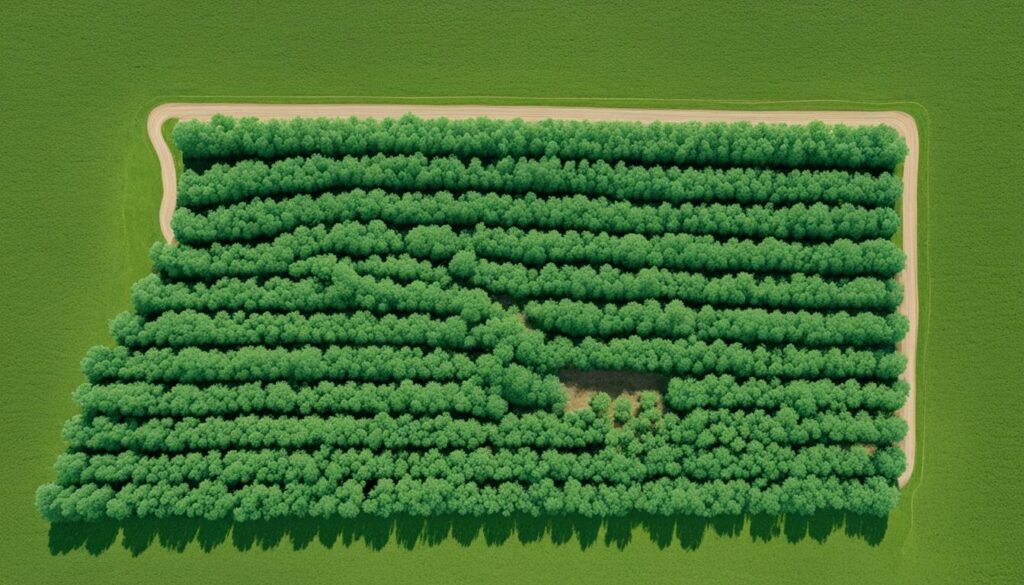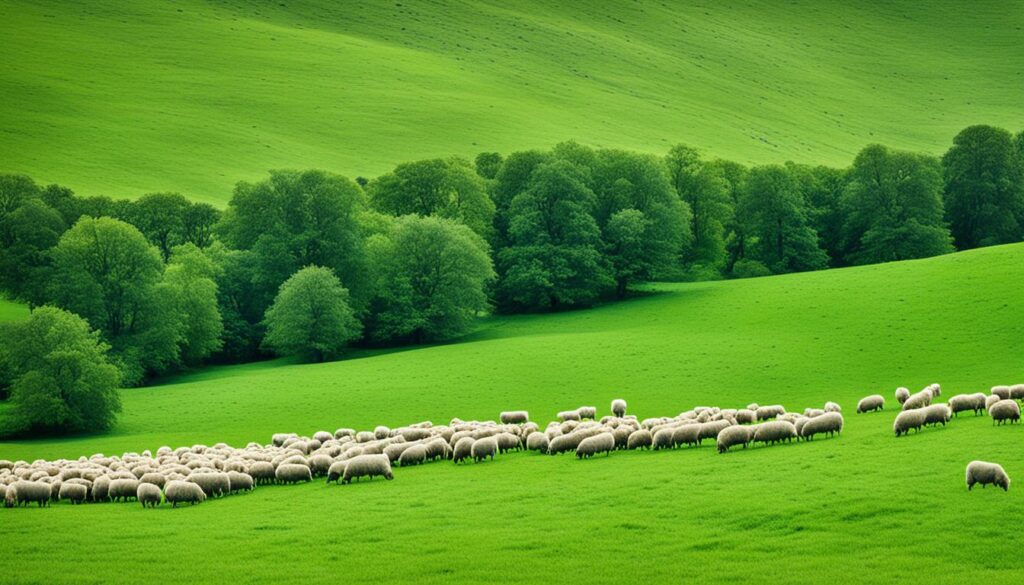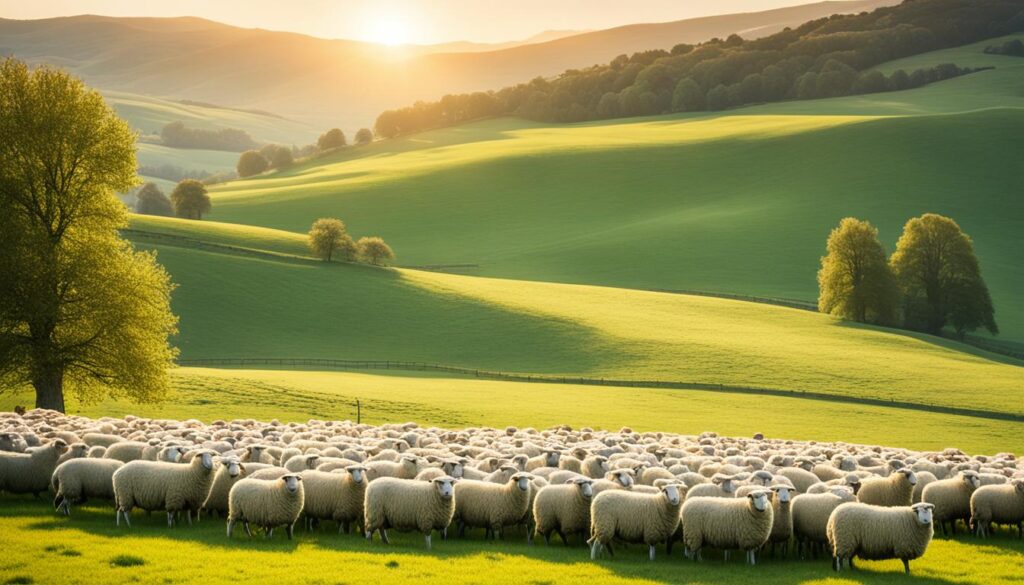Have you ever stood in the middle of a lush green pasture, watching a flock of sheep graze peacefully? There’s something undeniably serene and comforting about the sight, isn’t there? As you observe these gentle creatures, it’s easy to appreciate the delicate balance required to maintain their well-being and the health of the land they roam on.
Today, we’re going to explore a crucial aspect of sheep farming – the optimal number of sheep per acre for efficient grazing. Finding the right sheep density is not just about maximizing productivity; it’s about creating an environment where your flock thrives, while preserving the integrity of your pastures for future generations.
Join us on this journey of discovery as we delve into the factors that influence sheep density, such as stocking rate and grazing capacity. Together, we’ll uncover the secrets to maintaining healthy pastures and maximizing the efficiency of your grazing practices. Get ready to embark on a path that leads to harmony between your sheep and the land they call home.
Key Takeaways
- Understanding the optimal sheep per acre ratio is essential for efficient grazing and maintaining healthy pastures.
- Factors such as stocking rate and grazing capacity influence sheep density and must be taken into consideration.
- Assessing your pasture’s carrying capacity and grazing capacity is crucial for determining the appropriate sheep to land ratio.
- Pasture management practices, such as rotation and grazing systems, play a vital role in achieving the desired sheep per acre ratio.
- Regular monitoring and adjusting of the stocking rate are necessary for the long-term health and productivity of your pastures.
Understanding Stocking Rate for Sheep Grazing
Stocking rate is a fundamental concept in sheep farming, as it determines the number of animals that can graze on a specific area of land. Understanding the optimal sheep per acre ratio is crucial for ensuring efficient grazing and maintaining the health and productivity of your pastures. To achieve this, it is essential to consider the carrying capacity of your land and the grazing capacity for sheep.
Carrying capacity refers to the maximum number of animals that a given area of land can support without causing significant damage to the vegetation or compromising the ecosystem’s health. It is influenced by factors such as soil fertility, climate conditions, and the availability of forage resources. Assessing the carrying capacity of your land will help you determine the appropriate sheep population density.
Grazing capacity, on the other hand, is the amount of forage that an individual sheep can consume in a day. It depends on the sheep’s breed, age, and nutritional requirements. By understanding the grazing capacity of your sheep, you can calculate how many animals they can support per acre.
To determine the optimal sheep per acre ratio, you need to strike a balance between the carrying capacity and the grazing capacity. Consider factors such as the quality and quantity of forage available, the overall health of your pastures, and the nutritional needs of your flock. By ensuring that the number of sheep grazing on your land aligns with its carrying capacity and the individual sheep’s grazing capacity, you can optimize resource utilization and promote sustainable grazing practices.
“Proper understanding of stocking rate is essential for efficient grazing practices. By considering both the carrying capacity and grazing capacity, you can ensure optimal resource utilization and maintain healthy pastures for your sheep.”
To provide you with a practical example, consider the following table that illustrates the relationship between the carrying capacity, grazing capacity, and the recommended sheep per acre ratio for a specific sheep breed:
| Sheep Breed | Carrying Capacity (animals per acre) | Grazing Capacity (pounds of forage consumed per day) | Recommended Sheep per Acre Ratio |
|---|---|---|---|
| Merino | 4 | 2 | 8 |
| Dorper | 3 | 3 | 9 |
| Suffolk | 5 | 2.5 | 10 |
Factors Influencing Sheep Carrying Capacity
When determining the appropriate sheep to land ratio, it’s essential to consider the various factors that influence the sheep carrying capacity of a pasture. These factors play a crucial role in determining the sheep population density and ensuring the optimal utilization of available resources.
Type of Forage: The type and quality of forage available in the pasture significantly impact the number of sheep the land can support. Different forage species have varying nutritional values, growth rates, and palatability for sheep. A healthy mix of grasses, legumes, and other forbs can provide a balanced diet for a larger flock, increasing the sheep population density.
Soil Fertility: The fertility of the soil directly affects the availability and quality of nutrients for the forage plants. Adequate levels of essential nutrients, such as nitrogen, phosphorus, and potassium, promote healthy plant growth and higher forage yield. Well-maintained soil fertility contributes to improved sheep carrying capacity due to increased forage production.
Weather Conditions: The local climate, including rainfall patterns, temperature extremes, and seasonal variations, plays a crucial role in pasture productivity. Adequate rainfall and favorable weather conditions promote lush forage growth, leading to higher sheep carrying capacity. Conversely, droughts, heavy frosts, or extreme heat can decrease forage availability, limiting the number of sheep the land can sustain.
Overall Health of the Pasture: Pasture health encompasses factors like weed infestations, disease prevalence, and soil erosion. A healthy pasture with minimal weed competition and disease pressure can support a larger number of sheep per acre. Regular monitoring and appropriate management practices, such as rotational grazing, can help maintain pasture health and increase sheep population density.
“A healthy mix of grasses, legumes, and other forbs can provide a balanced diet for a larger flock, increasing the sheep population density.”

To summarize, understanding the factors influencing sheep carrying capacity, including the type of forage, soil fertility, weather conditions, and overall pasture health, is crucial for determining the appropriate sheep to land ratio. By considering these factors and implementing good pasture management practices, you can enhance the productivity and sustainability of your sheep farming operation.
Assessing Your Pasture's Grazing Capacity
Evaluating your pasture’s grazing capacity is crucial for determining the number of sheep your acreage can support. By considering factors such as forage yield, seasonal variations in pasture growth, and grazing rotations, you can ensure optimal sheep numbers per acre.
Forage Yield
The forage yield refers to the amount of available vegetation for grazing. It is influenced by factors such as soil fertility, climate, and management practices. Assessing your pasture’s forage yield involves estimating the biomass and nutritional value of the vegetation.
Seasonal Variations
It’s important to recognize that pasture growth varies throughout the year. Different seasons bring changes in temperature, rainfall, and daylight hours, which directly impact the availability and quality of forage. By understanding these variations, you can adjust your sheep’s numbers per acre accordingly.
Grazing Rotations
Implementing grazing rotations helps maximize pasture utilization and prevent overgrazing. It involves dividing your pasture into smaller sections and rotating sheep between them. This gives the vegetation time to recover, maintaining its health and productivity.
To calculate the appropriate sheep numbers per acre, you need to consider the carrying capacity, which is the maximum number of sheep your pasture can sustainably support. Carrying capacity depends on factors such as the size and condition of your pasture, its grazing potential, and your management practices.
Remember, proper pasture management and careful evaluation are essential for maintaining healthy and productive grazing land. Now let’s explore the factors that affect the optimal sheep density per acre in the next section.

Factors Affecting Optimal Sheep Density
Apart from environmental factors, several other considerations impact the optimal sheep density per acre. These factors include breed, age, nutritional requirements, and grazing management practices. By understanding how these factors influence sheep population density, you can ensure efficient grazing and maintain healthy pastures for your flock.
Breed: Different sheep breeds have varying requirements in terms of space and grazing resources. Some breeds are better suited to higher sheep densities, while others may require more acreage per sheep to meet their nutritional needs.
Age: The age of the sheep also plays a role in determining the optimal density per acre. Younger sheep may require more space to graze and grow, while mature sheep can efficiently utilize the available forage in a smaller area.
Nutritional Requirements: The nutritional needs of your sheep are crucial in determining the appropriate density per acre. Sheep with higher nutritional requirements, such as pregnant or lactating ewes, may need more grazing space to meet their dietary needs.
Grazing Management Practices: Effective grazing management practices can significantly impact optimal sheep density. Proper pasture rotation, rest periods, and implementing a grazing system that matches the forage production with the sheep population can help maintain healthy pastures and maximize grazing efficiency.
“Understanding these factors and their influence on optimal sheep density is essential for achieving efficient grazing and ensuring the well-being of your flock.”
The Role of Pasture Management for Efficient Grazing
Maintaining a well-managed pasture is crucial for maximizing grazing efficiency. By implementing effective pasture management practices, you can optimize the sheep per acre ratio and ensure the long-term health and productivity of your pastures.
Pasture Rotation
Pasture rotation is a key strategy in managing grazing lands for sustainable sheep production. By dividing your pasture into smaller paddocks and rotating your sheep between them, you allow the vegetation in each paddock to recover and regrow, ensuring a continuous supply of quality forage. This practice helps prevent overgrazing and promotes even distribution of grazing pressure, enhancing the sheep grazing capacity of your land.
Grazing Systems
Implementing appropriate grazing systems can significantly improve your sheep per acre ratio. Two commonly used systems are continuous grazing and rotational grazing. Continuous grazing allows sheep to graze freely throughout the pasture, while rotational grazing involves periodically moving the flock to different paddocks. Rotational grazing provides ample forage regrowth time and prevents selective grazing, resulting in better utilization of the available forage and increased stocking density. It also helps control parasite infestations and promotes pasture productivity.
âProper pasture management is essential for maximizing grazing efficiency and maintaining the long-term health and productivity of your land.â
Other Management Practices
In addition to pasture rotation and grazing systems, there are other management practices that contribute to efficient grazing and optimal sheep per acre ratios:
- Monitor Pasture Health: Regularly assess the health and condition of your pastures to identify potential issues such as soil nutrient deficiencies, weed encroachment, or erosion. Addressing these issues promptly can help maintain the sheep grazing capacity of your land.
- Water Management: Ensuring access to clean and sufficient water sources is crucial for the well-being and performance of your flock. Proper water management can also influence forage quality and availability.
- Supplemental Feeding: During periods of low forage availability or poor pasture conditions, providing supplemental feed can help meet your sheep’s nutritional requirements and avoid overgrazing.
- Pest and Disease Control: Implement effective pest and disease control measures to protect your flock and prevent pasture damage, ensuring optimal grazing conditions.
Remember, maintaining a well-managed pasture requires ongoing monitoring and adjustments to meet the specific needs of your flock and the condition of your land. By implementing these management practices, you can optimize the sheep per acre ratio, increase the sheep grazing capacity of your land, and ultimately, improve the productivity and profitability of your sheep operation.
Monitoring and Adjusting Sheep Stocking Rate
Regularly monitoring the condition of your pastures and the health of your sheep is essential for making adjustments to the stocking rate. By closely observing the state of your pastures, you can ensure optimal sheep carrying capacity and grazing capacity, which ultimately leads to efficient grazing and healthier flocks.
Assessing the condition of your pastures involves evaluating factors such as forage availability, pasture growth rates, and soil fertility. By keeping a close eye on these indicators, you can determine the appropriate sheep stocking rate that your land can support without compromising its health and productivity.
Additionally, monitoring the health of your sheep is crucial in maintaining an optimal stocking rate. Regular health checks, including weight monitoring, body condition scoring, and veterinary assessments, can help you gauge the condition of your flock and identify any potential issues or signs of distress.
Based on the condition of your pastures and the nutritional needs of your flock, you may need to adjust the stocking rate. This could involve increasing or decreasing the number of sheep per acre to ensure that the grazing pressure remains balanced and sustainable.
Pro Tip: Keep track of the sheep stocking rate, sheep carrying capacity, and sheep grazing capacity using a comprehensive record-keeping system. This will help you track trends over time and make informed decisions about adjusting the stocking rate effectively.
Regularly monitoring and adjusting the stocking rate is not only crucial for the well-being of your pastures and flock but also for maximizing the utilization of your land. By maintaining an appropriate stocking rate, you can optimize forage production, enhance pasture health, and improve the overall grazing efficiency on your farm.
| Pasture Condition | Recommended Stocking Rate |
|---|---|
| Excellent quality forage with high growth rates | Higher stocking rate to fully utilize available forage |
| Adequate forage with moderate growth rates | Moderate stocking rate to maintain pasture health |
| Scanty forage or poor growth rates | Lower stocking rate to prevent overgrazing and promote pasture recovery |
The table above provides a general guideline for adjusting the stocking rate based on pasture condition. However, it’s important to consider other factors such as weather conditions, seasonality, and the specific needs of your flock when determining the ideal sheep per acre ratio.
Remember, monitoring and adjusting the stocking rate is an ongoing process that requires regular observations and flexibility. By maintaining a close relationship with your land and flock, you can ensure sustainable and efficient grazing practices on your farm.
Considerations for Different Sheep Production Systems
When it comes to sheep production, the optimal sheep density per acre can vary depending on the specific farming system in place. Factors such as pasture-based systems, intensive grazing systems, and sheep production in arid or irrigated regions all play a role in determining the ideal sheep per acre ratio.
In pasture-based systems, where sheep graze on natural or cultivated pastures, the optimal sheep density per acre should be carefully managed to ensure sustainable grazing. Grazing rotations and monitoring pasture health are essential practices to maintain optimal sheep per acre ratios. By allowing pastures to rest and regenerate, you can provide fresh forage for your flock and prevent overgrazing.
In contrast, intensive grazing systems focus on maximizing production on smaller areas of land. These systems often involve smaller paddocks and frequent movements of sheep. The optimal sheep density per acre in intensive grazing systems can be higher compared to pasture-based systems, as long as the nutrition needs of the sheep are met and there is sufficient forage availability.
Sheep production in arid or irrigated regions presents unique challenges. The limited availability of water and forage requires careful management of sheep density to prevent overgrazing and ensure the sustainability of resources. The optimal sheep density per acre in these regions depends on factors such as water availability, forage quality, and the ability to effectively manage grazing.
It is important to note that these are general considerations, and optimal sheep density per acre may vary depending on specific conditions and management practices. Consulting with local agriculture experts or experienced farmers in your region can provide valuable insights tailored to your unique circumstances.
Comparing Optimal Sheep Density per Acre for Different Production Systems
| Production System | Optimal Sheep Density per Acre |
|---|---|
| Pasture-Based Systems | Varies based on pasture health and grazing rotation |
| Intensive Grazing Systems | Higher density, based on forage availability and nutrition requirements |
| Arid or Irrigated Regions | Varies based on water and forage availability, and grazing management |
As you can see, the optimal sheep density per acre can vary significantly depending on the production system in place. Understanding the specific factors that influence sheep grazing in each system is crucial for maintaining healthy pastures and maximizing production. By considering the unique needs of your flock and implementing sound management practices, you can achieve the optimal sheep density per acre for your specific production system.
Conclusion
In conclusion, determining the optimal sheep per acre ratio is essential for efficient grazing and maintaining healthy pastures for your flock. By considering various factors such as stocking rate, grazing capacity, carrying capacity, and pasture management, you can make informed decisions to maximize the productivity and sustainability of your sheep operation.
Regular monitoring of your pastures and the health of your sheep is crucial. This allows you to assess the condition of your pastures and adjust the stocking rate accordingly. By closely observing the forage yield, seasonal variations in pasture growth, and the nutritional needs of your flock, you can ensure that your sheep are provided with adequate grazing resources.
Implementing effective pasture management practices, such as rotational grazing and proper grazing systems, can further optimize your sheep per acre ratio. These practices promote pasture health and growth, prevent overgrazing, and enhance the utilization of available forage. Additionally, regularly monitoring pasture conditions allows you to identify any necessary adjustments to your grazing strategy.
Remember, achieving efficient grazing and maintaining healthy pastures is a dynamic process that requires ongoing assessment and adjustment. By staying informed about best practices and taking into account the unique characteristics of your land and flock, you can optimize your sheep per acre ratio and ensure the long-term success and sustainability of your sheep operation.
FAQ
What is the optimal sheep per acre ratio for efficient grazing?
The optimal sheep per acre ratio for efficient grazing depends on various factors such as the type and quality of forage available, soil fertility, weather conditions, and the overall health of the pasture. It is recommended to consult with a local agricultural extension agency or a livestock nutrition specialist to determine the specific optimal sheep density for your area.
How can I determine the stocking rate for sheep grazing?
Stocking rate refers to the number of animals grazing on a specific area of land. To determine the appropriate stocking rate for sheep grazing, you need to consider the carrying capacity of your land and the grazing capacity for sheep. Carrying capacity depends on factors such as forage availability and quality, while grazing capacity considers the nutritional needs of sheep. Regular monitoring and adjusting of the stocking rate based on the condition of your pastures and the nutritional requirements of your flock are essential for successful sheep grazing.
What factors influence the carrying capacity of a pasture for sheep?
The carrying capacity of a pasture for sheep is influenced by factors such as the type and quality of forage available, soil fertility, weather conditions, and the overall health of the pasture. These factors determine the amount of forage that can be sustainably consumed by sheep without depleting the pasture’s resources or compromising the health of the flock. It is important to regularly assess these factors and adjust the sheep to land ratio accordingly to maintain a healthy and productive pasture.
How do I assess my pasture’s grazing capacity for sheep?
Assessing your pasture’s grazing capacity involves considering factors such as forage yield, seasonal variations in pasture growth, and the timing of grazing rotations. By evaluating the amount of forage your acreage can provide and the nutritional needs of your sheep, you can calculate the number of sheep it can support. It’s important to monitor the condition of your pastures regularly and make adjustments to the sheep stocking rate in order to maintain optimal grazing conditions.
What are the additional factors that affect the optimal sheep density per acre?
Apart from environmental factors, the optimal sheep density per acre is influenced by factors such as breed, age, nutritional requirements, and grazing management practices. Different sheep breeds have varying forage consumption rates and nutritional needs. Furthermore, the age and productive stage of the sheep impact the amount of forage they require. Adequate nutrition and effective grazing management practices, such as rotational grazing, can help achieve optimal sheep density per acre and promote the overall health and productivity of the flock.
How does pasture management contribute to efficient sheep grazing?
Pasture management is crucial for efficient sheep grazing. Practices such as pasture rotation, proper grazing system implementation, and monitoring the condition of the pasture can help maintain an optimal sheep per acre ratio. By allowing pastures to rest and recover between grazing periods, you can ensure a continuous supply of nutritious forage and avoid overgrazing. Implementing good weed control and soil fertility management practices also contribute to the quality and quantity of forage available to the sheep.
How can I monitor and adjust my sheep stocking rate?
Monitoring the condition of your pastures and the health of your sheep is essential for making adjustments to the stocking rate. Regularly assess the forage availability, pasture growth, and body condition score of your flock. If pasture resources are being depleted or sheep are not maintaining adequate body condition, it may be necessary to reduce the stocking rate. Conversely, if the pasture is flourishing and sheep are not utilizing the available forage efficiently, increasing the stocking rate might be appropriate. It is recommended to consult with a livestock nutrition specialist or an agricultural extension agency for specific guidance based on your region and pasture conditions.
Are there considerations for different sheep production systems?
Yes, different sheep production systems have varying optimal sheep density per acre ratios. Pasture-based systems rely on grazing as the primary source of nutrition, while intensive grazing systems often supplement grazing with additional feed sources. Arid or irrigated regions may have different carrying capacities and require specialized management practices. It is important to consider the specific requirements and constraints of your production system when determining the ideal sheep per acre ratio for efficient grazing.



